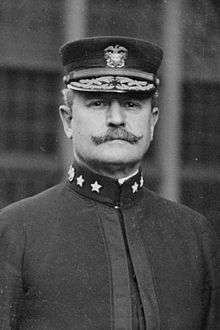Cameron Winslow
| Cameron McRae Winslow | |
|---|---|
 Admiral Cameron McRae Winslow | |
| Born |
July 29, 1854 Washington, D.C. |
| Died |
January 2, 1932 (aged 77) Boston, Massachusetts |
| Allegiance |
|
| Service/branch |
|
| Years of service | 1874–1916, c. 1917–1919 |
| Rank |
|
| Unit | USS Nashville |
| Commands held |
USS Charleston USS New Hampshire U.S. Pacific Fleet |
| Battles/wars |
Spanish–American War World War I |
| Relations | Rear Admiral John A. Winslow |
Admiral Cameron McRae Winslow (29 July 1854 – 2 January 1932) served in the United States Navy during the Spanish–American War and World War I. A son of Commander Francis Winslow (I) (1818–1862), (Cameron's father, who also fought in the Civil War, and died of Yellow Fever in 1862 while in command of the USS R. R. Cuyler (1860), was a first cousin of John A. Winslow.)
He was a first cousin once removed of Rear Admiral John A. Winslow, who served in the Civil War and is best known as the commanding officer of the U.S.S. Kearsarge which defeated the C.S.S. Alabama.
Early life and family
Cameron McRae Winslow was born in Washington, D.C. His older brother was Lieutenant Francis Winslow (II) USN; his younger brother, Arthur Winslow, was the grandfather of the Pulitzer Prize-winning poet Robert Lowell. He graduated from the United States Naval Academy in 1874, after which followed years of extensive sea duty.
He was married to Theodora Havemeyer (c. 1877–1945), one of the many children of sugar baron Theodore A. Havemeyer and Emilie De Loosey Havemeyer.
Cameron McRae Winslow, Jr.
Winslow was the father of Cameron McRae Winslow, Jr. (1901-1981), who graduated from the United States Naval Academy in 1924. Winslow, Jr. received the Navy Cross for heroism while in command of the armed guard on board the S.S. Chi Ping from 12 March to 14 March 1930, on the Yangtze River, near Ichang, China. While moving on the river, the vessel was taken under heavy fire on several occasions from Chinese soldiers. Winslow returned fire promptly so that in each instance the attack was repulsed and the vessel permitted to continue its voyage. During an attack on 14 March, Winslow was struck in the thigh by a rifle bullet. He did not give up command of his detachment but continued firing a machine gun. He served in the early years of World War II and was retired from the Navy for medical reasons on April 1, 1943 with the rank of lieutenant commander.[1]
Naval career
During the 1898 war with Spain, then Lieutenant Winslow served on board Nashville. He was commended for extraordinary heroism when, on 11 May 1898, he commanded a boat expedition from Nashville and Marblehead which succeeded in cutting two submarine cables off Cienfuegos, Cuba, which linked Cuba with Europe. Despite withering enemy fire from point-blank range, which resulted in a bullet wound to his hand, Winslow retained command throughout the engagement. At that time, regulations did not allow Navy officers to receive the Medal of Honor. However, all the enlisted sailors involved in the cable cutting operation did receive the Medal of Honor.
Winslow commanded Charleston from 1905 to 1907 and battleship New Hampshire from 1908 to 1909. Winslow did not sail on the around-the-world cruise of the Great White Fleet. When the fleet returned to the US in 1909, Winslow and the New Hampshire joined the fleet for its formal military review before President Roosevelt.
Promoted to rear admiral on 14 September 1911, Winslow was Commander in Chief, United States Pacific Fleet, from 13 September 1915 until 29 July 1916 when he was retired due to reaching the statutory age limit of 62. (While in command of the Pacific Fleet, he held four-star Admiral rank pursuant to a 1915 law that designated holders of certain commands to temporary 4-star rank; see List of United States Navy four-star admirals.)
Winslow was recalled to active duty in World War I with the rank of rear admiral. He served as Inspector of Naval Districts on the Atlantic coast until again retiring on 11 November 1919. While in this assignment, Winslow's flagship was the USS Aloha, a private sailing yacht acquired by the Navy for use during the war.
Retirement
Following the 1908 death of his oldest brother, Lt. Francis Winslow (II) USN, Rear Admiral Winslow became a member of the Society of the Cincinnati in the State of New Hampshire, representing his direct ancestor Major General John Stark. The Admiral's younger brother, Arthur Winslow, also joined the Society, representing the General's oldest son, Major Caleb Stark.
Winslow was also a member of the Military Order of Foreign Wars and the Naval Order of the United States.
Admiral Winslow died in Boston, Massachusetts on 2 January 1932.
Legacy
The first two ships named USS Winslow honored his cousin, Rear Admiral John Ancrum Winslow, and Winslow (DD-359) honored Rear Admiral Cameron McRae Winslow as well.
Admiral Winslow's full dress uniform is on display at the Artillery Company of Newport museum in Newport, Rhode Island.
Awards
Dates of rank
- Midshipman – 29 September 1870
- Passed Midshipman – 21 June 1875
- Ensign – 18 July 1876
- Master – 21 December 1881
- Lieutenant, Junior Grade – 3 March 1883
- Lieutenant – 1 July 1888
- Lieutenant Commander – 3 March 1899
- Commander – 11 October 1903
- Captain – 28 January 1908
- Rear Admiral – 14 September 1911
- Admiral – 13 September 1915
- Retired – 29 July 1916
References
- This article incorporates text from the public domain Dictionary of American Naval Fighting Ships.
- "Winslow". Dictionary of American Naval Fighting Ships. Naval Historical Center, Department of the Navy. Retrieved 2007-05-30.